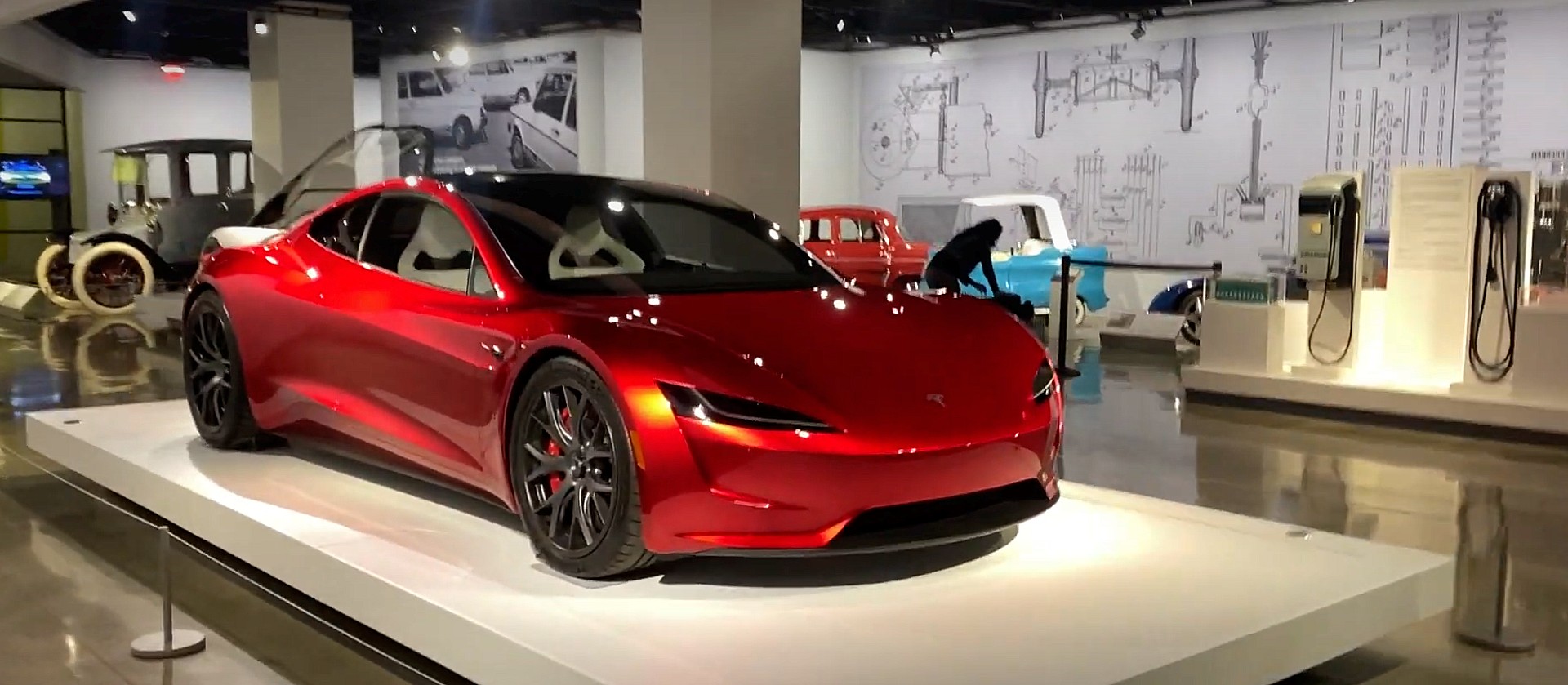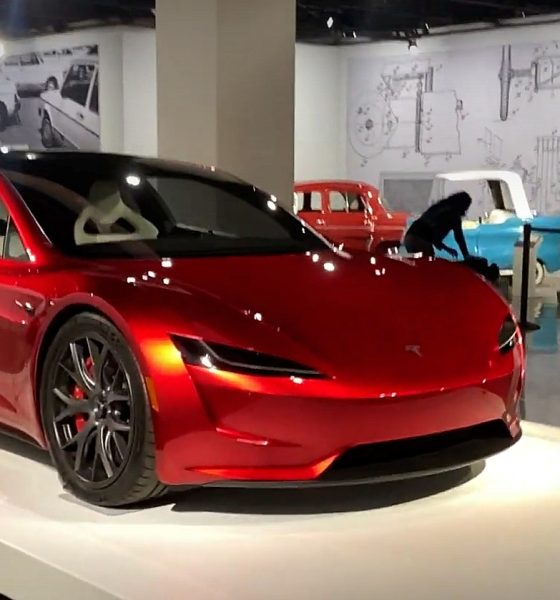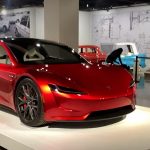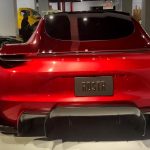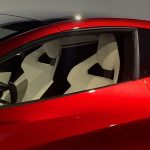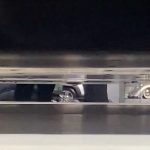Tesla’s next-generation Roadster is officially on display at the Petersen Automotive Museum in Los Angeles, and spectators are getting their first glimpses of the all-electric supercar.
Last week, it was announced that the Tesla Roadster would arrive at the Petersen Auto Museum for a two-week-long appearance in its own specialized exhibit. Tesla’s “halo car,” as it has been described in the past, is on display from today, May 19th, until June 2nd, 2021.
Now that the Roadster is officially in the Los Angeles museum, spectators are getting their first glimpses of the all-electric supercar ahead of its production push, which is scheduled to occur next year. Tesla unveiled the Roadster in 2017, but the company has focused primarily on increasing production of its mass-market vehicles, solving battery constraint bottlenecks, and working on producing its passenger cars before working on getting the Roadster in production.
Thanks to the YouTube account “gaussdog,” we are getting our first looks at the Roadster in the exhibit.
- Credit: YouTube | gaussdog
- Credit: YouTube | gaussdog
- Credit: YouTube | gaussdog
- Credit: YouTube | gaussdog
It appears that not much has changed with the Roadster since its last public appearance at Tesla’s Battery Day and Shareholder Meeting in September 2020. Since then, Tesla CEO Elon Musk has revealed some new details about the Roadster’s potential capabilities, including the ability to hover using a SpaceX package that would utilize cold gas thrusters to help it gain altitude. Additionally, these thrusters could be placed on the back of the vehicle to increase the Roadster’s already face-melting 0-60 MPH time of less than 1.99 seconds, similar to the Plaid+ Model S that was revealed in January.
Musk commented on the vehicle’s potential hovering ability during an interview with Joe Rogan:
“I want it to hover. I’m trying to figure out how to make this thing hover without, you know, killing people. I thought maybe we could make it hover, but not too high. So maybe it could hover, like, a meter above the ground, or something. So, if you plummet, you blow out the suspension, but you’re not going to die. Maybe, I don’t know, six feet. If we put a height limit on it, it will probably be fine.”
Musk added that the vehicle would be able to travel while in mid-air and that it would move “pretty fast.” However, he believes that certain restrictions should be put into place to decrease the risk of an accident. He mentioned a time restriction system that would automatically ground the vehicle after a certain period of time.
Acknowledging that the hovering may not be possible, Musk does believe that Tesla could still install thrusters behind the license plate to increase thrust.
Tesla Roadster could hit 0-60 mph in 1.1 sec with SpaceX thrusters
Musk plans to have a “release candidate design drivable by late Summer” and noted that finalizing the tri-motor drive system and advanced battery work were “important precursors” to solve before production begins.
Petersen has an “After Hours Experience” set up for the Roadster as well, and the cost is $45 per ticket and has limited availability. General admission tickets cost $16 for adults, $11 for children, and $14 for seniors.
Check out the first video of the Roadster from the Petersen Automotive Museum below, courtesy of gaussdog.
What do you think? Let us know in the comments below, or be sure to email me at joey@teslarati.com or on Twitter @KlenderJoey.

Elon Musk
Elon Musk’s X will start using a Tesla-like software update strategy
The initiative seems designed to accelerate updates to the social media platform, while maintaining maximum transparency.

Elon Musk’s social media platform X will adopt a Tesla-esque approach to software updates for its algorithm.
The initiative seems designed to accelerate updates to the social media platform, while maintaining maximum transparency.
X’s updates to its updates
As per Musk in a post on X, the social media company will be making a new algorithm to determine what organic and advertising posts are recommended to users. These updates would then be repeated every four weeks.
“We will make the new 𝕏 algorithm, including all code used to determine what organic and advertising posts are recommended to users, open source in 7 days. This will be repeated every 4 weeks, with comprehensive developer notes, to help you understand what changed,” Musk wrote in his post.
The initiative somewhat mirrors Tesla’s over-the-air update model, where vehicle software is regularly refined and pushed to users with detailed release notes. This should allow users to better understand the details of X’s every update and foster a healthy feedback loop for the social media platform.
xAI and X
X, formerly Twitter, has been acquired by Elon Musk’s artificial intelligence startup, xAI last year. Since then, xAI has seen a rapid rise in valuation. Following the company’s the company’s upsized $20 billion Series E funding round, estimates now suggest that xAI is worth tens about $230 to $235 billion. That’s several times larger than Tesla when Elon Musk received his controversial 2018 CEO Performance Award.
As per xAI, the Series E funding round attracted a diverse group of investors, including Valor Equity Partners, Stepstone Group, Fidelity Management & Research Company, Qatar Investment Authority, MGX, and Baron Capital Group, among others. Strategic partners NVIDIA and Cisco Investments also continued support for building the world’s largest GPU clusters.
News
Tesla FSD Supervised wins MotorTrend’s Best Driver Assistance Award
The decision marks a notable reversal for the publication from prior years, with judges citing major real-world improvements that pushed Tesla’s latest FSD software ahead of every competing ADAS system.

Tesla’s Full Self-Driving (Supervised) system has been named the best driver-assistance technology on the market, earning top honors at the 2026 MotorTrend Best Tech Awards.
The decision marks a notable reversal for the publication from prior years, with judges citing major real-world improvements that pushed Tesla’s latest FSD software ahead of every competing ADAS system. And it wasn’t even close.
MotorTrend reverses course
MotorTrend awarded Tesla FSD (Supervised) its 2026 Best Tech Driver Assistance title after extensive testing of the latest v14 software. The publication acknowledged that it had previously criticized earlier versions of FSD for erratic behavior and near-miss incidents, ultimately favoring rivals such as GM’s Super Cruise in earlier evaluations.
According to MotorTrend, the newest iteration of FSD resolved many of those shortcomings. Testers said v14 showed far smoother behavior in complex urban scenarios, including unprotected left turns, traffic circles, emergency vehicles, and dense city streets. While the system still requires constant driver supervision, judges concluded that no other advanced driver-assistance system currently matches its breadth of capability.
Unlike rival systems that rely on combinations of cameras, radar, lidar, and mapped highways, Tesla’s FSD operates using a camera-only approach and is capable of driving on city streets, rural roads, and freeways. MotorTrend stated that pure utility, the ability to handle nearly all road types, ultimately separated FSD from competitors like Ford BlueCruise, GM Super Cruise, and BMW’s Highway Assistant.
High cost and high capability
MotorTrend also addressed FSD’s pricing, which remains significantly higher than rival systems. Tesla currently charges $8,000 for a one-time purchase or $99 per month for a subscription, compared with far lower upfront and subscription costs from other automakers. The publication noted that the premium is justified given FSD’s unmatched scope and continuous software evolution.
Safety remained a central focus of the evaluation. While testers reported collision-free operation over thousands of miles, they noted ongoing concerns around FSD’s configurable driving modes, including options that allow aggressive driving and speeds beyond posted limits. MotorTrend emphasized that, like all Level 2 systems, FSD still depends on a fully attentive human driver at all times.
Despite those caveats, the publication concluded that Tesla’s rapid software progress fundamentally reshaped the competitive landscape. For drivers seeking the most capable hands-on driver-assistance system available today, MotorTrend concluded Tesla FSD (Supervised) now stands alone at the top.
News
Elon Musk’s Grokipedia surges to 5.6M articles, almost 79% of English Wikipedia
The explosive growth marks a major milestone for the AI-powered online encyclopedia, which was launched by Elon Musk’s xAI just months ago.

Elon Musk’s Grokipedia has grown to an impressive 5,615,201 articles as of today, closing in on 79% of the English Wikipedia’s current total of 7,119,376 articles.
The explosive growth marks a major milestone for the AI-powered online encyclopedia, which was launched by Elon Musk’s xAI just months ago. Needless to say, it would only be a matter of time before Grokipedia exceeds English Wikipedia in sheer volume.
Grokipedia’s rapid growth
xAI’s vision for Grokipedia emphasizes neutrality, while Grok’s reasoning capabilities allow for fast drafting and fact-checking. When Elon Musk announced the initiative in late September 2025, he noted that Grokipedia would be an improvement to Wikipedia because it would be designed to avoid bias.
At the time, Musk noted that Grokipedia “is a necessary step towards the xAI goal of understanding the Universe.”
Grokipedia was launched in late October, and while xAI was careful to list it only as Version 0.1 at the time, the online encyclopedia immediately earned praise. Wikipedia co-founder Larry Sanger highlighted the project’s innovative approach, noting how it leverages AI to fill knowledge gaps and enable rapid updates. Netizens also observed how Grokipedia tends to present articles in a more objective manner compared to Wikipedia, which is edited by humans.
Elon Musk’s ambitious plans
With 5,615,201 total articles, Grokipedia has now grown to almost 79% of English Wikipedia’s article base. This is incredibly quick, though Grokipedia remains text-only for now. xAI, for its part, has now updated the online encyclopedia’s iteration to v0.2.
Elon Musk has shared bold ideas for Grokipedia, including sending a record of the entire knowledge base to space as part of xAI’s mission to preserve and expand human understanding. At some point, Musk stated that Grokipedia will be renamed to Encyclopedia Galactica, and it will be sent to the cosmos.
“When Grokipedia is good enough (long way to go), we will change the name to Encyclopedia Galactica. It will be an open source distillation of all knowledge, including audio, images and video. Join xAI to help build the sci-fi version of the Library of Alexandria!” Musk wrote, adding in a later post that “Copies will be etched in stone and sent to the Moon, Mars and beyond. This time, it will not be lost.”
